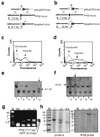Impaired antiviral response and alpha/beta interferon induction in mice lacking beta interferon
- PMID: 10708458
- PMCID: PMC111842
- DOI: 10.1128/jvi.74.7.3404-3409.2000
Impaired antiviral response and alpha/beta interferon induction in mice lacking beta interferon
Abstract
We have generated mice lacking the gene for beta interferon and report that they are highly susceptible to vaccinia virus infection. Furthermore, in cultured embryo fibroblasts, viral induction of alpha interferon and of 2-5A synthetase genes is impaired. We also show that beta interferon does not prime its own expression.
Figures




References
-
- Abramovich C, Chebath J, Revel M. The human interferon alpha-receptor protein confers differential responses to human interferon-beta versus interferon-alpha subtypes in mouse and hamster cell transfectants. Cytokine. 1994;6:414–424. - PubMed
-
- Alcami A, Smith G L. A soluble receptor for interleukin-1 beta encoded by vaccinia virus: a novel mechanism of virus modulation of the host response to infection. Cell. 1992;71:153–167. - PubMed
-
- Asano M, Hayashi M, Yoshida E, Kawade Y, Iwakura Y. Induction of interferon-alpha by interferon-beta, but not of interferon-beta by interferon-alpha, in the mouse. Virology. 1990;176:30–38. - PubMed
-
- Billiau A, Joniau M, De Somer P. Mass production of human interferon in diploid cells stimulated by poly-I:C. J Gen Virol. 1973;19:1–8. - PubMed
-
- Colamonici O R, Domanski P, Sweitzer S M, Larner A, Buller R M. Vaccinia virus B18R gene encodes a type I interferon-binding protein that blocks interferon alpha transmembrane signaling. J Biol Chem. 1995;270:15974–15978. - PubMed
Publication types
MeSH terms
Substances
Grants and funding
LinkOut - more resources
Full Text Sources
Other Literature Sources
Molecular Biology Databases

